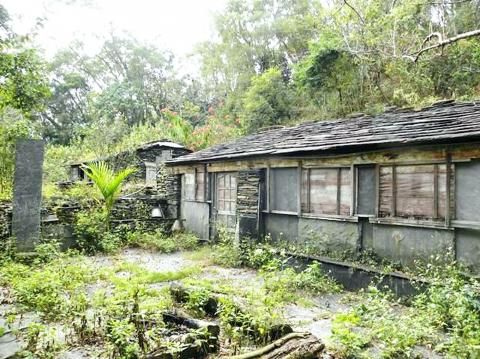Increasing attention from the international community is being given to cultural sites across Taiwan, with the most recent being the inclusion of an abandoned Rukai village on next year’s world monuments watchlist run by the New York-based World Monument Fund.
It is the second nomination of a Taiwanese sites to be included on the list, which was first published in 1996 and is released once every two years, seeking to draw attention to threatened cultural heritages around the world.
The first Taiwanese site on the list was the Wangan community building in Penghu County in 2004.

Photo courtesy of the Pingtung County Government
Next year’s list features 50 sites in 36 nations, dating from ancient history to the 20th century.
A World Monument Fund report released on Thursday in New York City said the “sites on the 2016 watch are emblematic of preservation issues that are prevalent around the globe ... a call to action that brings the fragility of these sites and the dangers they face to international attention.”
Next year’s list includes the Palace of Justice in Brussels, the Wentworth Woodhouse in England, Albania’s Spac Prison and the almost entirely abandoned Rukai village in Wutai Township (霧台), Pingtung, it said.
The village is inhabited by only one couple, who are hunters by profession, according to the Pingtung County government.
Commonly known as the Haocha community (好茶), or Kucapungane, the site is where legend has it that the people’s ancestors built a village where a Formosan clouded leopard had led them.
The village is 1,000m above sea level and has more than 600 years of history.
The Rukai relocated to Sinhaocha (新好茶) in 1974 to be closer to modern infrastructure, leaving behind more than 100 buildings built from stone plates.
The World Monument Fund, which was founded in 1965, said the unique skill used to construct the houses, built from hand-cut black and gray shale slabs, and the rich cultural history of the people were reasons for its inclusion of the village on the list.
Despite designation by the government as a national monument, the village deteriorated over four decades of disuse, with frequent typhoons exacerbating the problem, the non-profit organization said.
It said it hopes the listing highlights “the importance of the fragile physical remains of Kucapungane as well as the associated intangible Rukai heritage,” adding that local government and private organizations should strive to protect the site.
Kucapungane leader Ko Kuang-hui (柯光輝) said he cried tears of joy after hearing of the listing.
Ko said he hopes the move would also prompt society to help preserve the site.
He said that after two moves, the second in 2009 following Typhoon Morakot, many Rukai cultural relics had been lost.
The people consider the village their spiritual homeland, he added.
Members of the Kucapungane Rukai make periodic visits to the village and Ko said they hope the local government would help repair the Haocha Bridge to facilitate our way home, adding that one day they hoped to move back to Kucapungane.

The US government has signed defense cooperation agreements with Japan and the Philippines to boost the deterrence capabilities of countries in the first island chain, a report by the National Security Bureau (NSB) showed. The main countries on the first island chain include the two nations and Taiwan. The bureau is to present the report at a meeting of the legislature’s Foreign Affairs and National Defense Committee tomorrow. The US military has deployed Typhon missile systems to Japan’s Yamaguchi Prefecture and Zambales province in the Philippines during their joint military exercises. It has also installed NMESIS anti-ship systems in Japan’s Okinawa

‘WIN-WIN’: The Philippines, and central and eastern European countries are important potential drone cooperation partners, Minister of Foreign Affairs Lin Chia-lung said Minister of Foreign Affairs Lin Chia-lung (林佳龍) in an interview published yesterday confirmed that there are joint ventures between Taiwan and Poland in the drone industry. Lin made the remark in an exclusive interview with the Chinese-language Liberty Times (the Taipei Times’ sister paper). The government-backed Taiwan Excellence Drone International Business Opportunities Alliance and the Polish Chamber of Unmanned Systems on Wednesday last week signed a memorandum of understanding in Poland to develop a “non-China” supply chain for drones and work together on key technologies. Asked if Taiwan prioritized Poland among central and eastern European countries in drone collaboration, Lin

Renewed border fighting between Thailand and Cambodia showed no signs of abating yesterday, leaving hundreds of thousands of displaced people in both countries living in strained conditions as more flooded into temporary shelters. Reporters on the Thai side of the border heard sounds of outgoing, indirect fire yesterday. About 400,000 people have been evacuated from affected areas in Thailand and about 700 schools closed while fighting was ongoing in four border provinces, said Thai Rear Admiral Surasant Kongsiri, a spokesman for the military. Cambodia evacuated more than 127,000 villagers and closed hundreds of schools, the Thai Ministry of Defense said. Thailand’s military announced that

CABINET APPROVAL: People seeking assisted reproduction must be assessed to determine whether they would be adequate parents, the planned changes say Proposed amendments to the Assisted Reproduction Act (人工生殖法) advanced yesterday by the Executive Yuan would grant married lesbian couples and single women access to legal assisted reproductive services. The proposed revisions are “based on the fundamental principle of respecting women’s reproductive autonomy,” Cabinet spokesperson Michelle Lee (李慧芝) quoted Vice Premier Cheng Li-chiun (鄭麗君), who presided over a Cabinet meeting earlier yesterday, as saying at the briefing. The draft amendment would be submitted to the legislature for review. The Ministry of Health and Welfare, which proposed the amendments, said that experts on children’s rights, gender equality, law and medicine attended cross-disciplinary meetings, adding that